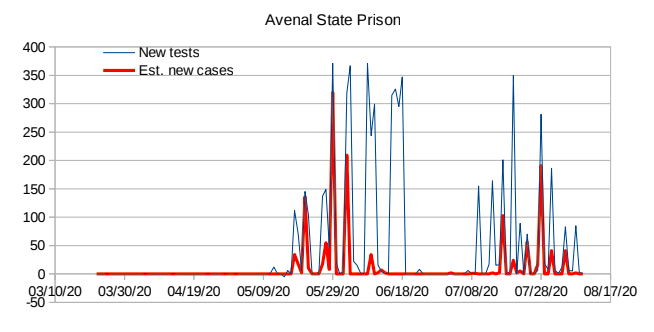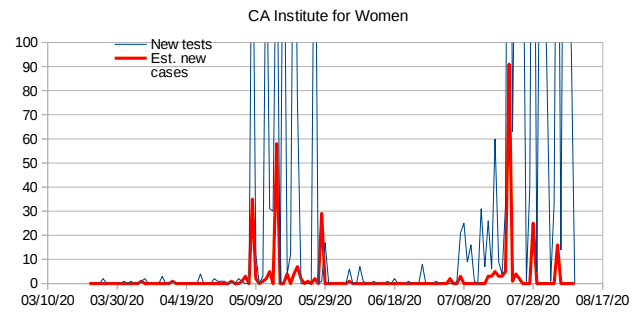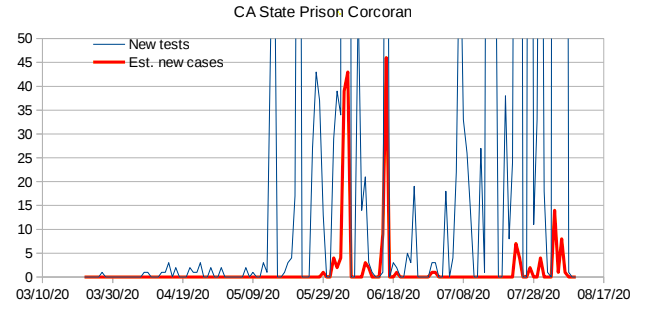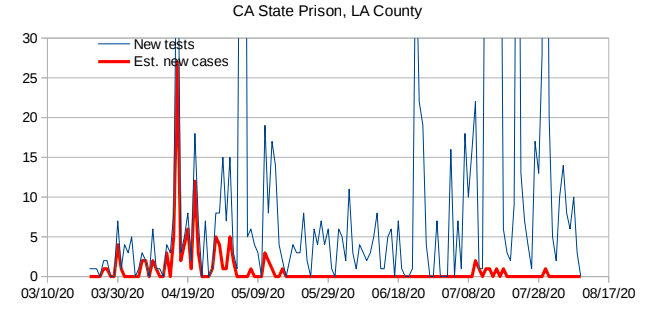
I’m noticing public attention wavering away from the San Quentin disaster, and my concern is that the slowing down of the contagion has lulled people into a false assumption that the prison is doing what it should and conquering this challenge. Lest you believe this, let’s talk about what’s happened in other places. Avenal (pictured above) is a case in point. As in previous posts, Chad Goerzen and I are using CDCR’s own data, from the COVID-19 tracking tool.
The outbreak in Avenal happened early on in the pandemic, and was probably one of the most severe outbreaks before the transfer from CIM to Quentin. Avenal’s casualties were among the first behind bars, too. At the beginning of June, most tests were coming in negative, and prison authorities probably thought that the outbreak had abated. Then, in mid-July, case numbers started climbing up again.
Another example is CIW, pictured below. Note the alarming numbers in early May, the decline in testing (and in cases! in late May and in June, and then the spike in numbers of cases in mid- to late-July.

There are other examples of apparent abatement followed by a resurgence of the outbreak. Here’s the data for CMC, where initially there were only a handful of cases. As opposed to other prisons, you can see that CMC continued to test people periodically, on a weekly basis, even when they had no contagion, and the in late July they caught a new wave with dozens of new infections.

Here’s the picture for Corcoran, which seems to have had three waves of outbreak. You’ll note that one of them followed the ill-fated transfer from Chino. Corcoran did test a lot of people in early July and found no infections, but toward mid- to late-July we’re seeing infections again.

Finally, here’s a more ambiguous resurgence in LA County State Prison. Note that this prison was conducting very few tests between the two waves, so what they are seeing from early July onward could simply be a consequence of the increased testing.

What can we learn from this, particularly from the examples of Avenal and CIW? The obvious takeaway is that a serious outbreak does not protect a prison from a recurrence. There are numerous reasons for this. The jury’s apparently still out as to the extent to which recent infection and recovery effectively inoculate a person against a recurrence. It seems that people who get reinfected are less contagious, but this is highly dependent upon their medical condition and environmental immunosuppression (and there’s no absolute certainty that the person was actually reinfected after recovery, rather than just continuously sick or just expelling dead cells.) If, indeed, reinfection is possible–whether or not to the same contagious extent–then a mere staff member who gets takeout on the way home could restart the cycle. But this is exacerbated by the renewal of prison transfers which, I believe, start again today. We now know, because (or, actually, despite) the scant reporting from BSCC, that several jails are hotbeds of COVID-19, with dozens, and sometimes hundreds, of infections. The slow drip of people out of state prisons is going to be offset by the incoming bottleneck of people from jails, and one can only hope against hope that they’ll bother testing people on both ends of the transfer this time.
In short, keep your eyes on the human rights crime. It’s slowing down not because we are succeeding, but because the virus is succeeding. And state officials–at the Governor’s mansion, at the prisons, at the courts–are not doing enough to stop it in its tracks.




No comment yet, add your voice below!